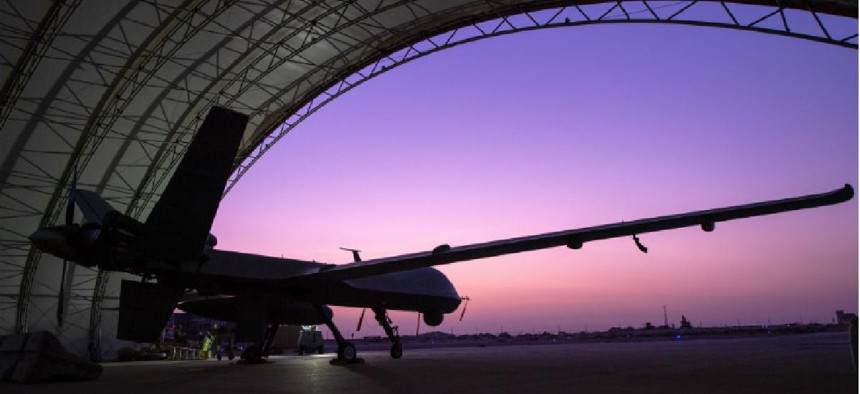How the Air Force upgraded cyber testing for weapons systems

Air Force Materiel Command's 96th Test Wing is modernizing the way the service tests weapons systems for cybersecurity vulnerabilities.

U.S. Air Force MQ-9 Reaper drone pictured at Ali Al Salem Air Base, Kuwait, July 23, 2019. (Photo credit: Tech. Sgt. Michael Mason/U.S. Air Force)
The Air Force is leaning on agile and DevOps methodologies to help boost cybersecurity while testing new weapons systems.
Brig. Gen. Scott Cain, commander of Air Force Materiel Command's 96th Test Wing at Eglin Air Force Base in Florida, told FCW that "agile development, having developers there alongside the testers" was one of the test center's initiatives, along with increasing partnerships across the Air Force and with its software factories such as Kessel Run. Doing so in conjunction with using common industry techniques allow the service to "rapidly add capability and get it in the field," he said.
That model is being pushed furthest with the 96th Test Wing in the Air Force Test Center's cyber testing group, Cain said. The center's portfolio largely consists of new capabilities focused on modernizing the Air Operations Centers, but networking aircraft to be efficient with multi-domain command and control will churn out key developments over the next six to 18 months, Cain said.
Cain called the DevOps model one of the "most exciting things" because it enabled better collaboration when developers and operational testers in the same lab are working on new weapons system capabilities for air and cyber combat.
The cyber group's work is inherently focused on multi-domain operations, namely networking legacy systems so current Air Force assets in inventory can apply lethal effects.
"It's all about ensuring that every one of them has the opportunity to apply an effect ... those hundreds of attack vectors. And the only way to do that is if our systems are all networked," Cain said. "We don't have open architectures in all of those legacy systems. We can build them into our future systems, but we don't necessarily have that to leverage. How we do that moving back into our legacy systems is certainly a challenge."
In 2017 the Air Force stood up the cyberspace test group, which originated with the 46th Test Squadron that primarily tested networks and mission planning systems. The group, which is based at Eglin Air Force Base, has test units at six other locations in the U.S. and includes three subordinate squadrons -- the 45th and 46th Test Squadrons and the 47th Cyberspace Test Squadron.
The change added another layer to operational testing and reorganized the Test Center's cyber testing capabilities under the group's single command with the mission to pursue initiatives involving command and control, communications, computers, cybersecurity operations, electronic warfare and intelligence, surveillance and reconnaissance.
The Defense Department has also increased its focus on tightening and unifying cybersecurity standards across its networks and systems. Multiple Government Accountability Office reports stressed the cybersecurity vulnerabilities in DOD's weapons systems with one targeting software sustainment to help bolster cyber protections.
The services, in turn, have been shoring up their systems and processes too. The Air Force has been undergoing a months-long cybersecurity review and recently announced merging its cyber and information operations, combining Air Combat Command's 24th and 25th Numbered Air Forces into one: the 16th Air Force, which will focus on information warfare.
Amid an increased focus on new cyber effects, Cain said one of his main goals for 2020 and beyond is to reinforce the testing infrastructure to support new networked weapons and be more data compatible.
"Having the ability to test these future weapons requires us to transform our infrastructure and ranges that we do this on, expanding the capability to gather data on those ranges," Cain said, adding there were discussions ongoing to ensure adequate budgeting and resources for range improvements.






